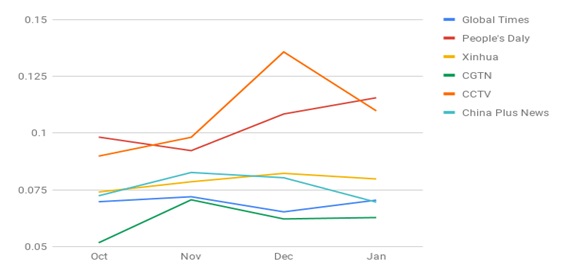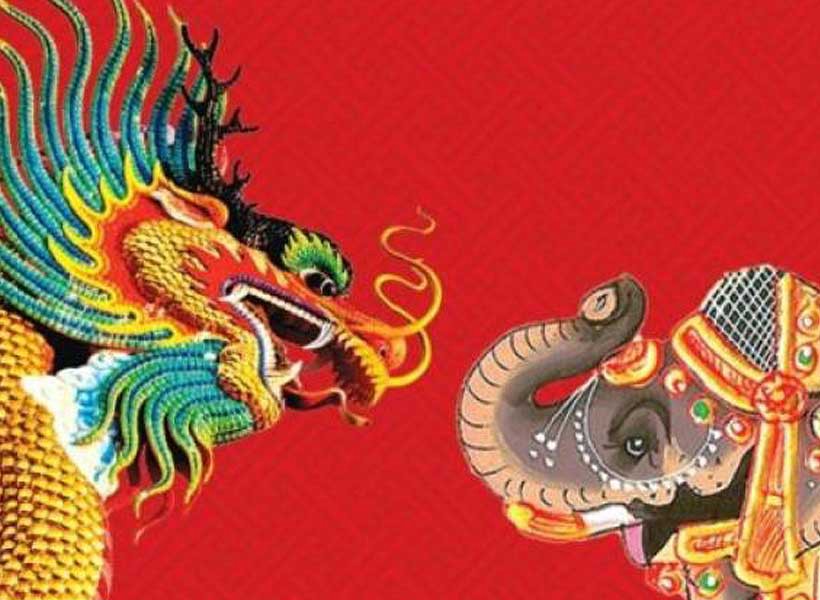As it naturally happens in our great nation, we love to live from crisis to crisis. Aamir Khan in the movie Ghazni made the term ‘short term memory loss’ as part of our household lexicon but this affliction is embedded in our DNA as a nation. The capriciousness of this malice has been capitalized on by TRP hungry media houses, I am reminded of a famous song by Roxette; ‘C’mon Join the Joy Ride’ when we listen to the debates and rants on prime time TV.
And then of course the ‘New Media’ — the citizen journalists who with a smartphone and a social media account can influence the opinion of the nation; be it on Facebook or Twitter. The ‘Twitterati’ are the microcosm of our society, ranting, raving, debating and of course the sound of sanity in the cacophony emerges for nanosecond before it’s drowned again in the morass of chaos. Having described our state of mind, or the lack of it, for the adversary this is a fertile ground for sowing seeds of self-doubt and influencing the mind. Since the crisis in Eastern Ladakh commenced in May 2020, Global Times has become a primary source of Chinese influence operations in India, as I script this piece, it has 1.9 Million followers and is the oft quoted reference point for Chinese views and opinions. Knowing very well that it’s the mouth piece of the Chinese Government and it says so ‘China state-affiliated media’ and its status reads ‘China’s National English Language Newspaper under the People’s Daily’. We have allowed it to cloud our judgment as a nation.
Way back in 2016, Russian defense expert Vasily Kashin had commented on PLA Strategic Support Force (SSF); “Apart from the former Third and Fourth Departments of the PLA General Staff Headquarters, which were responsible for the technical reconnaissance, cyber intelligence, electronic warfare and offensive cyber operations, the new forces will be responsible for the military intelligence at large and for the psychological operations in particular. It will also incorporate the Foreign Affairs Bureau of the former PLA General Political Department, responsible for political warfare and propaganda operations targeted at the army and population of an enemy.”[1]
If we had not developed the symptoms of dementia and taken corrective measures, we would have remembered that SSF is the driving force behind whatever Xinhua or Global Times spew out as news. A seminal work done by French Military called Information Manipulation; A Challenge for Our Democracies “China controls more than 3,000 public television channels in the world, over 150 pay TV channels, around 2,500 radio stations, about 2,000 newspapers and 10,000 magazines and more than three million internet sites”[2] and Global Times is surely one amongst them.
China has had a long history of the use of propaganda and today, this know-how is at the service of Chinese interests on a global scale. Beijing has developed tools of influence and interference that are specifically geared towards offensive intentions. Effort on the ideological front has two objectives: First, to shape the internal political space and maintain the Party’s legitimacy (through censorship and disinformation); Second, to influence international opinion and wage the “information war” in favor of Chinese interests.
Information warfare is an integral dimension of PLA’s strategy of influence and intimidation. Chinese strategists brought to fore the manifestation of the “three wars” (sanzhan) in the field of information even during Doklam crisis[3]. Combining the war for public opinion, psychological warfare and legal warfare, this approach is intended — in peacetime as in wartime — to control the dominant discourse and influence beliefs and perceptions so as to serve the interests of the PLA, while also reducing the ability of adversaries to respond.[4]
This strategy, which explicitly targets public opinion in democracies, exploits the vulnerabilities of open societies like ours and gullible minds or may be senile minds of some of our strategists and experts who in turn become mouth pieces of PLA which then enjoys systematic and multi-vector information manipulation and control capabilities. Chinese content then is broadcast in Hinglish conveying positions and principles that are contrary to Indian interests; a rather convoluted form of HMV (His Master’s Voice). This dimension goes well beyond the framework of conventional conflict and forms part of the deeply volatile and ambiguous hybrid conflict where in the definition of battle space and combatants is a farrago.
On the contrary, internet control and surveillance was initially introduced under the guise of the Golden Shield Project[5] (金盾工程), a massive series of legal and technological initiatives meant to improve intelligence assessments and surveillance capabilities of the national police force. Among the techniques developed at the time was a system for blocking and censoring content known as the “Great Firewall”[6] designed to keep Chinese cyberspace free of pollutants of all sorts, by the simple means of requiring ISPs [internet service providers] to block access to ‘problem’ sites abroad. The Chinese have mastered the art of quarantine and one of the recent events was banning of WION website in China[7].
While they can go ahead and influence the world the QPQ in information domain has been severely constrained. Chinese state or can be read as PLA too, also employs a series of active disinformation and distortion measures to influence social media users. One of the most widely studied has been the so-called “50 Cent Party.” This group of people hired by the Chinese government to surreptitiously post large numbers of fabricated social media comments, as if they were the genuine opinions of ordinary Chinese people, it was initially meant for the domestic audience but its success has prompted the PLA to engage them internationally too. The name is derivative of a rumor that these fake commentators were paid 50 Chinese cents per comment.
The Chinese government has surely sought to use state and PLA resources to influence how Indians view China in this standoff. What separates the influence operations of today from those of 1962 are two factors; First, the ubiquity and impact of social media, and Second, the expanded intent and scope. While he continues to adopt old tactics of playing ‘Bhangra Music’ at the Friction Points[8], the proliferation of social media platforms, the increasingly broad range of services offered, and the ability to engage with (and not just broadcast to) the intended gullible Indian audience offers him deeper strategic reach. Over the course of the past decade, social media platforms have evolved to play an ever-expanding role in the lives of users. In India Indians spend more than 280 minutes a day on social media[9], due to the COVID pandemic lockdown which is an increase of 87% of what was the normal usage prior to the pandemic. Indians have begun to trust the reliability of social media more than traditional news platforms and credit must go to our firebrand anchors who want to know everything even if the nation doesn’t want to (pun intended) and be the judge, jury and executioner on every aspect of our lives, reminds me of old Amitabh Bachchan movies like Shahenshah and further, social media companies increasingly offer users a wider array of services, pulling more of the average user’s time and attention to their platforms.
The last five months has demonstrated that propaganda, the foundation for PLA run influence operations, can still be highly effective, even if it is perceived as overt. This is for the following five reasons:-
(a) We as people are poor judges of true versus false information, and they do not necessarily remember that particular information was false (short term memory loss again).
(b) Information overload leads people to take shortcuts in determining the trustworthiness of messages.
(c) Familiar themes or messages can be appealing, even if they are false and especially if they are anti-establishment or aimed at bashing and grinding an organization to death and some more.
(d) Statements are more likely to be accepted if backed by evidence, even if that evidence is false.
(e) Peripheral cues, such as an appearance of objectivity, can increase the credibility of propaganda.
China seeks to convince the world as a whole and India in particular that its development and rise is unfailingly positive, beneficial, cooperative and constructive for the global community. While sentiment analysis can be inexact and possesses a mixed track record, it is most useful on large data sets like this one. Vader sentiment analysis[10] technique and code from their Github repository indicate positive sentiment on the scale as greater than 0.05 and the various Chinese media houses are all above the datum of 0.05.

PLA has a set of strategic goals, and to achieve it, Chinese state-run social media influence operations are a key Line of Effort (LoE). China’s goal to exert greater influence on the Indian mind during the current imbroglio by portraying the Chinese as indestructible on one side and a benevolent and constructive vector for the region on the other has proven successful thanks to our short term memory loss. China has attempted to influence the Indian population through messages, propaganda, and media influencers some even home grown and military trained too. The travails of a democratic society have been exploited to the hilt and China has inserted an intentionally distorted and biased narrative “for hostile purposes.” In order to advance its aims on a competitive playing field that is hardly level, China propagated a distorted and convoluted view of our government and the armed forces of India. Chinese information manipulation on social media can be countered only by identifying the goals and techniques of these influence operations and then by countering their deleterious agents and effects they generate.
[1] https://sputniknews.com/asia/201601191033349605-china-strategic-support-forces/
[2] J.-B. Jeangène Vilmer, A. Escorcia, M. Guillaume, J. Herrera, Information Manipulation: A Challenge for Our Democracies, report by the Policy Planning Staff (CAPS) of the Ministry for Europe and Foreign Affairs and the Institute for Strategic Research (IRSEM) of the Ministry for the Armed Forces, Paris, August 2018, pg 59.
[3] Indrani Bagchi, Doklam Standoff: China playing out its ‘Three War fares’ strategy against India, https://timesofindia.indiatimes.com/india/china-playing-out-its-three-warfares-strategy-against-india/articleshow/60036197.cms
[4] Elsa B. Kania, “The PLA’s Latest Strategic Thinking on the Three Warfares,” China Brief, XVI:13, August 2016, p. 10–14.
[5] Chandel, Sonali & Jingji, Zang & Yunnan, Yu & Jingyao, Sun & Zhipeng, Zhang. (2019). The Golden Shield Project of China: A Decade Later — An in-Depth Study of the Great Firewall. 111–119. 10.1109/CyberC.2019.00027.
[6]https://cs.stanford.edu/people/eroberts/cs181/projects/20101/FreeExpressionVsSocialCohesion/china_references.html
[7] https://www.dnaindia.com/world/report-as-china-blocks-access-to-wion-support-pours-in-from-readers-across-the-world-2830759
[8] https://timesofindia.indiatimes.com/india/new-pla-tactics-punjabi-songs-warning-to-indian-troops-in-hindi/articleshow/78158229.cms
[9]http://timesofindia.indiatimes.com/articleshow/74879674.cms?utm_source=contentofinterest&utm_medium=text&utm_campaign=cppst
[10] Hutto, C.J. & Gilbert, E.E, VADER: A Parsimonious Rule-based Model for Sentiment Analysis of Social Media Text. Eighth International Conference on Weblogs and Social Media (ICWSM-14). Ann Arbor, MI, June 2014.

